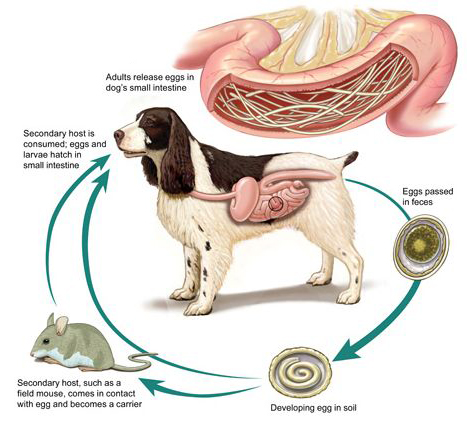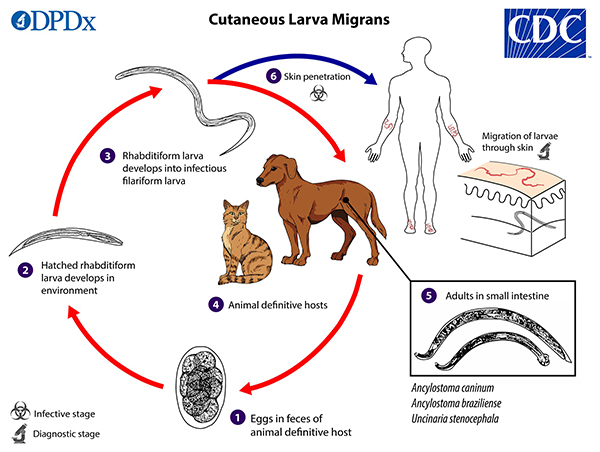Heartgard Plus Chewables for Dogs
Everything about HeartGard chewables

What is Heartgard Plus?
HeartGard protects dogs against

Heartworm

Roundworm & Hookworm
3 different weight ranges
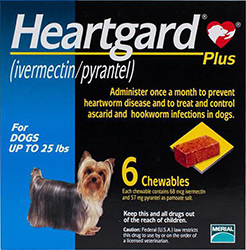 |
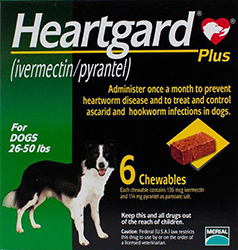 |
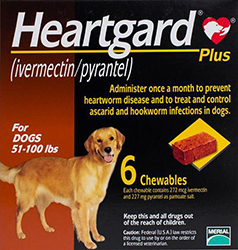 |
|
|---|---|---|---|
| Dog Weight (lbs) | Below 25 | 26-50 | 51-100 |
| Dog Weight (kg) | Below 11 | 12-22 | 23-45 |
| Chewable size (mm) | 25 | 32 | 38 |
| Ivermectin (mcg/chew) | 68 | 136 | 272 |
| Pyrantel (mg/chew) | 57 | 114 | 228 |
Active ingredients
Ivermectin
Ivermectin is a broad-spectrum antiparasitic that treats or prevents both internal and external parasites in pets and livestock, depending on the dose and method of application. In the formulation for Heartgard Plus, it is used only for the prevention of heartworm in dogs.
Ivermectin is not effective in killing adult heartworm, but rather prevents heartworm disease by killing the heartworm at the tissue larval stage before it can develop. Ivermectin is part of a group of drugs known as macrocyclic lactones, which can cause adverse effects for dogs with the MDR-1 mutation, including Collies. The dose provided in Heartgard Plus has been established as safe for use with all dog breeds.
Pyrantel
Pyrantel is an endoparasiticide, meaning is it used against internal parasites. In the case of Heartgard Plus, it is formulated for the treatment of roundworms and hookworms in dogs.
The drug works by acting directly on the nervous system of the worms, disrupting the transmission of signals between the nerves and muscles. As a result, the worms become paralysed. They either die quickly due to paralysis or become unable to attach themselves to the lining of the intestines, at which point they are expelled from the body.
Heartgard Plus vs Other Brands
There are plenty of parasites that your dog will come into contact with over the course of its life. And unfortunately, due to the different ways that parasites impact an animal, there is no single medication that will protect or treat all pests at once. However, with the right combination, you may only need 2 to 3 medications to provide your dog with full-spectrum protection.
Each medication comes with its pros and cons, which is why you should always be as informed as possible before deciding on the treatment that’s best for your dog.
 |
 |
 |
 |
 |
|
|---|---|---|---|---|---|
| Type of Application | Chewable | Chewable | Tablet | Tablet | Chewable |
| Prevents Heartworm | ✔️ | ✔️ | ✔️ | ✔️ | |
| Prevents Roundworms | ✔️ | ✔️ | ✔️ | ||
| Prevents Hookworms | ✔️ | ✔️ | ✔️ | ||
| Safe for Pregnant or Nursing Pets | ✔️ | ✔️ | ✔️ | ||
| Active Ingredient(s) | Ivermectin, Pyrantel Pamoate | Ivermectin | Milbemycin Oxime, Lufenuron | Spinosad, Milbemycin Oxime | Afoxolaner |
| Dosage | Monthly | Monthly | Monthly | Monthly | Monthly |
Parasites
Heartworm
(Dirofilaria immitis)
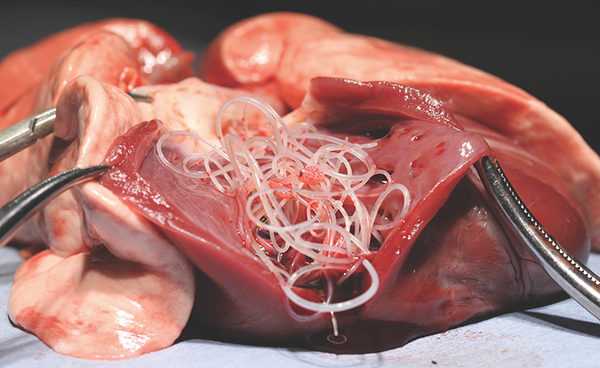
Heartworm is one of the most problematic parasites that can affect your dog, due to the fact that they are so hard to eliminate. The heartworms themselves are very easily transmitted and when heartworm disease develops it is not only life-threatening for your dog, but costly and difficult to treat. Prevention is the most effective way to make sure your dog remains safe from this deadly disease.
These deadly parasites were at one point only found in the southern United States, but have now spread to nearly all parts of the country and most continents. Unlike many other parasites, heartworm cannot be spread directly from host to host. Heartworm is only spread through the bite of an infected mosquito and as such, tropical and temperate climates offer a much higher risk.
Heartworms affect not only dogs, but cats, wolves, coyotes and foxes among others. Locations that have a high population of any of these animals will greatly increase the risk of your dog contracting heartworm.
Heartworm disease is the name given to the condition in which the heartworms that are transmitted to your dog develop into adults, causing damage to the lungs, heart and arteries. The adult worms grow up to a foot long, and will continue to reproduce unless treated, with reported cases of up to 250 worms living inside a single dog.
Roundworm
(Toxocara canis, Toxascaris leonine)
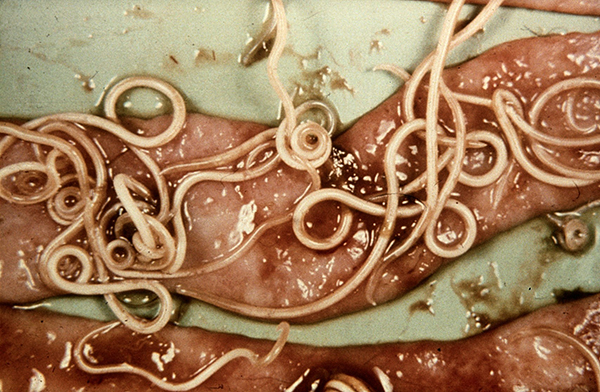
Adult roundworms are found in your dog’s digestive tract where they live, feed and reproduce. They do not attach themselves to the wall of the intestines in the way that some other worms do, instead they move freely around, eating partially digested food.
Symptoms of roundworm
It’s not unusual for a healthy adult dog to be infected with roundworms and not show any symptoms. However, you may notice signs of the roundworm in your dog’s faeces or vomit, where they are will show as white or light brown and up to several inches long.
Roundworms cause the most problems for puppies, but dogs with large number of roundworms can also be seriously affected by symptoms including:
- Diarrhea
- Vomiting
- Weight loss
- Pot-bellied appearance
- Dull coat
If the roundworms have moved into the lungs, they can cause coughing and respiratory issues.
How roundworms are transmitted
One of the reasons roundworms are so common is that they are very easily spread, and can be transmitted in a great number of ways.
The first way that dogs might come into contact with these intestinal worms is actually before they are born – it’s possible for the mother to transmit the roundworms through the uterus to the puppies. If the mother is infected with roundworms, she can also pass the larvae through her milk as she is nursing. For this reason, it’s important that all breeding dogs are treated for roundworm.
The most common way that adult dogs contract roundworm is through their environment. As adult roundworms lay eggs in the intestines, they are passed out via the faeces and often into the soil. A dog licking grass or even sniffing at the faeces of another dog can then ingest the eggs where they go on to develop in the body. A dog that has walked on contaminated soil then licked at its paws also has the risk of contracting roundworms in this way.
Finally, roundworms may be passed on from another host. Small animals such as birds, rodents, cockroaches and worms can also pick up the eggs from contaminated soil. If you dog eats one of these infected animals, the roundworm eggs will pass into their system and continue their lifecycle.
Roundworms in humans
These intestinal worms are what’s known as a zoonotic parasite, meaning that they can be transmitted between different species, including humans. Roundworms can actually cause serious issues, particularly for young children and pregnant women. An untreated roundworm infestation in humans can cause problems with the eyes, lungs and heart or even neurological issues.
Hookworm
(Ancylostoma caninum, Uncinaria stenocephala, Ancylostoma braziliense)
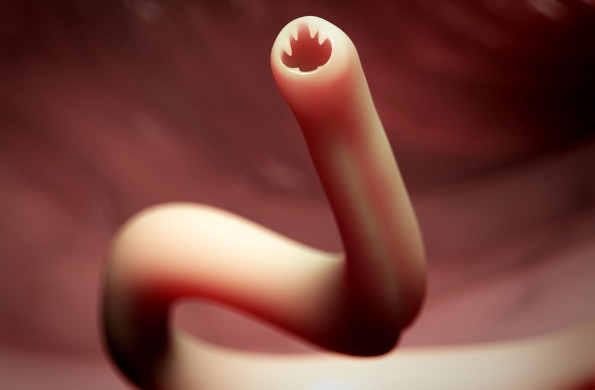
This is the name of several species of intestinal worms that can affect dogs. They are named for the hook-like parts in their mouths, which they used to attach to the intestinal lining of their host. Here they suck blood and other nutrients, leading to some unpleasant issues for your dog, even proving fatal in some cases.
Hookworms are a worldwide risk for dogs, but some species are more prevalent in particular areas. The preferred habitat of Ancylostoma caninum is tropical climates and the species is mainly found in Southeast Asia. Uncinaria stenocephala is the most common hookworm in cooler climates, while Ancylostoma braziliense is widespread through North, Central and South America, South Africa and some parts of Asia.
Symptoms of hookworm
Due to the way that hookworms feed, most symptoms are associated with the blood loss that they cause. It’s particularly problematic for puppies, who don’t have the reserves of blood that adult dogs do, and may need blood transfusions to survive.
Symptoms of hookworm in dogs include:
- Anaemia
- Pale gums
- Dark, sticky stools
- Lethargy
- Weight loss or failure to grow
- Coughing
As hookworms can enter the host through the skin, dogs that have contracted the parasite in this way may have red, itchy lesions at the site of entry, usually on the paws.
How hookworms are transmitted
Just as with roundworms, hookworms can also be passed from a mother to her unborn puppies through the placenta. Puppies may also be infected after birth as larva pass through the mother’s milk as they are nursing.
One of the keys to hookworm transmission is that after the eggs are laid and expelled from the host, they develop into larvae and they can remain dormant for weeks or even months in the soil or water while waiting for a new host. Dogs licking or sniffing the soil or drinking contaminated water will be infected with the hookworm larvae which will then continue their lifecycle.
Hookworms can also be transmitted directly through the skin, as the dog walks on contaminated soil. The larvae burrow through the skin, usually in between the toes.
Hookworms in humans
Heartworm disease
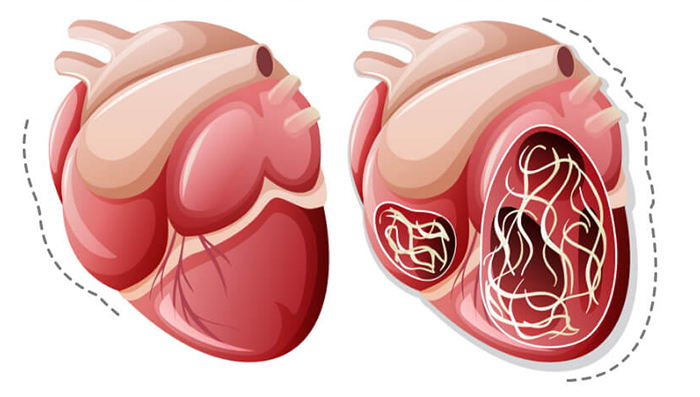
There are many parasites and diseases that dogs will come into contact with during the course of their life, but heartworms are one of the most problematic. There are a number of reasons why pet owners should be particularly aware of how this parasite can affect their dog.
The first is that it is very easily transmitted, meaning simply avoiding infection is not an option. The second is that unlike other worms or parasites, there is no medication that can easily eliminate the parasite from the body. The final and most important reason is that heartworm disease can cause incredible damage to the body and is usually fatal if not detected and treated early.
How heartworm is transmitted
Symptoms and stages of heartworm
The first stage of heartworm disease is when the larvae have entered the body of your dog, but have not yet matured into breeding adults. At this stage your dog will not usually display any signs or symptoms. At this stage it is still possible to eliminate the larvae using a heartworm preventative.
As the larvae mature and reproduce in the heart and lungs, they will begin to cause issues for your dog. You may notice signs such as a light cough or a reluctance to exercise. As the heartworms are now adults, they are detectable via a blood test. Heartworms that have reached the adult stage can no longer be eliminated via regular medication.
As the disease progresses and the heartworms reproduce, your dog will now display obvious signs of the disease. At this point the heartworms are large enough to be seen with an x-ray. The most common symptoms are:
- Lethargy or reluctance to exercise
- Fatigue after even moderate exercise
- Breathing difficulties
- Persistent coughing, often accompanied by blood
In the advanced stages of heartworm disease, the symptoms will be the same, but much more pronounced. At this point the heartworms will have caused damage to the organs including the lungs, heart and liver, which will remain even if the heartworms are eliminated. While treatment at this stage is possible, the damage already caused may cause debilitation or death.
How heartworm is treated
If a blood test reveals the presence of adult heartworms in your dog, you will need to begin a heartworm treatment program with your veterinarian.
The first step will be to conduct more tests to determine how many worms are present, what size they are and if any damage has been done to the organs. These tests may include x-rays or radiographs to check for any enlargement of the heart or obstructions to the arteries, or ultrasounds to examine the structure of the heart, lungs and liver. The next steps will depend on the severity of the disease and your dog’s condition.
As exercise speeds up the rate at which heartworms cause damage to the heart and lungs, your dog will need to be prevented from exercising during the course of their treatment. This can often be very difficult for active dogs. In advanced cases, dogs may have to be prevented from moving at all by placing them in a crate.
If your dog is experiencing serious symptoms, your vet will also need to stabilise these problems. This may include pain relief, antibiotics to kill bacteria that live alongside the heartworm, diuretics to remove fluid that may have built up in the lungs, and drugs to improve heart function. In severe cases the dog may need to be hospitalised until these immediate conditions are stabilised.
Treatment for adult heartworms does not usually occur until 60 days after the initial diagnosis. This allows for the health problems to be stabilised and for any preparatory medication to take effect. Your vet will also start your dog on a heartworm preventative to ensure no new infections occur once treatment has started.
In order to eliminate the worms themselves, your vet will administer a series of adulticide injections. For the first injection your dog may be required to stay overnight with the vet so that they can be monitored for any adverse reactions. Your vet may prescribe a steroid treatment to prevent inflammation.
One month after the first injection, your dog will require two injections spaced 24 hours apart. Again, your dog may be required to stay in for observation. An interim assessment will be conducted one month later to determine if the treatment is working and to check the progress of any health problems.
Even if your vet determines that the treatment is working correctly, your dog will still need to be restricted. As adult heartworms die, their bodies are pushed by the blood flow into the smaller branches of the vessels that send blood to the lungs. With any kind of exercise at all, there is the increased risk that these dead worms can block blood flow, leading to complications including death.
Six months after the first injections, your vet will do a blood test to check that all adult heartworms have been successfully eliminated from the body.
Parasite lifecycles
Heartworm

Microfilariae
Heartworms start their life as these microscopic offspring, which the females release into the bloodstream of the host. Over their five-year lifespan the adult can produce millions of microfilariae. As the mosquito feeds on the host, they take up the microfilariae with them in the blood.
Infective larvae
Adults
Eggs
Infective larvae
Adults
After the larvae have come up through the lungs and been swallowed again, they end up in the digestive tract, which becomes their final home. Here they continue to develop into adult roundworms, reaching mating age within a week of their return – 4 to 5 weeks after the initial infection.
Eggs
As with other intestinal worms, hookworms start life as eggs, which are released into the intestines of the host and passed out via the faeces and into the environment. With the right conditions (moisture, warmth and shade), these eggs will hatch into larvae within 1 to 2 days. At this stage they are not infective. After two stages of moulting that take around 5 to 10 days, the hookworms emerge as infective larvae.
Infective larvae
Adults
Tips for preventing worms in dogs
Preventative medication
This is obviously the most valuable thing you can do for your dogs in terms of worms. In the case of heartworm, a preventative medication is the only way to ensure that any larvae they contract do not develop into heartworm disease. In the case of intestinal worms, this medication is not actually a preventative, but a treatment. If your dog has been infected with hookworms or roundworms, this medication will eliminate them from the body, disrupting the breeding cycle.
Regular check-ups
Keep their home clean
In the case of hookworm and roundworm, one of the most common methods of transmission is via contaminated soil or water. Even in your own yard it is important that you clean up faeces as soon as possible. Be aware that containers such as buckets fill with rainwater and become a potential breeding ground for mosquitos, which are the vector for heartworms.
Eliminate pests
Make sure your dog is healthy
Myths about heartworm
Heartworm disease is only a risk in summer
False. While it is true that mosquitoes are more prevalent during the warmer months or in warmer climates, your dog is at risk wherever there is even a single mosquito. Even in cold climates, mosquitos have been known to survive the winter months by taking shelter indoors, or in sheds or kennels.
Heartworm disease is rarely fatal
Dogs taking heartworm preventatives don’t require annual testing
Heartworms are contagious
Mosquitos need to stay attached to transmit heartworm
It’s easy to tell if a dog has heartworm disease
False. In the early stages of this condition, it is very common for dogs to display no symptoms at all. By the time that begin to show the diseases typical symptoms such as coughing, the disease is often established and treatment may be difficult. This is why it is so important to continue with annual testing even if you have been administering a preventative medication.
Side effects
Side effects following the administration of Heartgard Plus are rare, with vomiting and diarrhea observed in just 1.1% of cases studies. Less common side effects include lethargy, loss of appetite, dilated pupils, loss of coordination, staggering, drooling and convulsions.
Overdose can occur, especially when giving a small dog a dose that is intended for larger dogs. Signs of overdose include vomiting, diarrhea, staggering, dilated pupils and lethargy. If you suspect your dog has had an overdose, please contact your veterinarian immediately.
Precautions
Dogs must be tested and cleared for existing heartworm before you begin administration of Heartgard Plus. If your dog is found to be infected, it will require treatment to remove the heartworm before starting use of Heartgard Plus.
When storing, administering or disposing of Heartgard Plus, it is important that you:
- Keep this and all medication out of reach of children and other pets
- Do not remove the chewable from the blister pack until you are ready to administer
- Remove only one chewable at a time
- In the case of accidental ingestion by humans, contact a doctor immediately
- Store between 68°F – 77°F (20°C – 25°C) away from light
- Dispose of empty packaging or unused chewables responsibly – ivermectin may be toxic to marine life
Our review
Package contents
Inside the box there is a blister pack containing the chews. The chews are a rectangular shape, regardless of the dosage. On the blister pack you will also see here there are heart-shaped stickers – these are used to stick over the monthly spaces on the back of the box which serve as a reminder for the next dose.
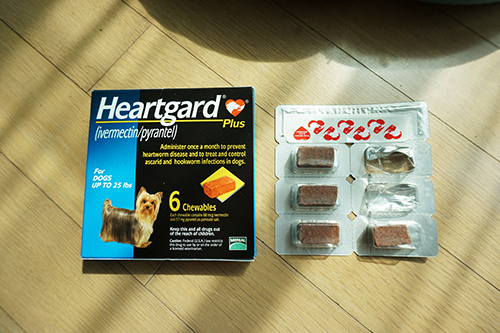
Front packaging and blister pack
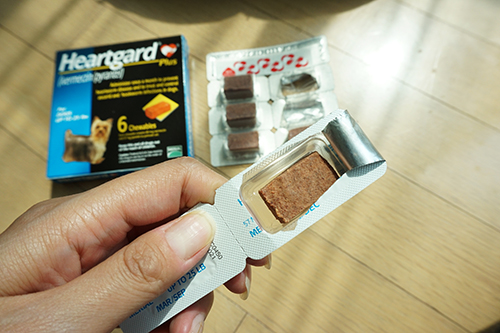
Wrapped nicely
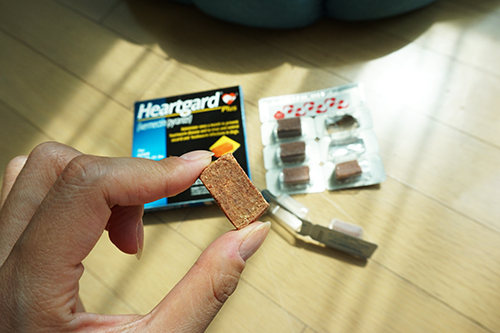
Tasty chewable

Your dog will love it!
Application
After giving Heartgard Plus to your dog, you should monitor them to make sure that they don’t drop, spit out or vomit any of the chewable. If this happens, you’re advised to redose.
Heartgard Plus needs to be chewed for maximum effectiveness. If your dog likes to swallow food whole without chewing, you should break up the chew into smaller pieces and administer them this way.
Pros
- Month long protection against heartworm, roundworm and hookworm
- Oral formula means no messy application
- Chewable design is great for dogs that won’t swallow tablets
Cons
- Does not protect against fleas or ticks
- Active ingredient Ivermectin may cause sensitivities in some dogs
FAQs
Can I use Heartgard Plus with any breed of dog?
Yes, Heartgard Plus is well tolerated and has been tested as safe for use in all breeds of dogs, including Collies.
Can I give Heartgard Plus to pregnant or nursing dogs?
Yes, Heartgard Plus has been evaluated as safe for use with breeding, pregnant or lactating dogs.
Does Heartgard Plus need to be given with food?
No, Heartgard Plus is designed to be given as a treat and can be given at any time of day, with or without food.
My dog weighs more than 100 lb (45 kg), what dose of Heartgard Plus do they need?
For dogs weighing more than the maximum weight listed on the package, they will need the appropriate combination of chewables. For example, a dog weighing 120 lbs (54 kg), will need one chewable for dogs weighing 51-100 lb, plus one chewable for dogs weighing up to 25 lbs.
Can I use Heartgard Plus with other medications?
In clinical studies, Heartgard Plus has been successfully used with other medications including flea collars, worming medications, medicated shampoos and antibiotics. If you have any concerns about using Heartgard Plus with other medication, please contact your veterinarian.
Where to buy
 |
 |
 |
|
|---|---|---|---|
| Score | ⭐⭐⭐⭐⭐ 5/5 |
⭐⭐⭐ 3/5 |
⭐⭐ 2/5 |
| Price of Heartgard Plus | From $66.95 | From $79.95 | From $76.95 |
| Free worldwide shipping | ✔️ | ❌ | ❌ |
| Shipping time | 3-7 business days | 14-20 business days | 10-15 business days |
| Auto-delivery option | ✔️ | ✔️ | ✔️ |
| Accepts return | ✔️ | ✔️ | ✔️ |
| 24/7 support | ✔️ | ❌ | ❌ |
| Wide range of products | ✔️ | ✔️ | ✔️ |
| Loyalty program | ✔️ | ❌ | ✔️ |
| User-friendly storefront | ✔️ | ✔️ | ✔️ |
| Multilingual storefront | ✔️ | ❌ | ❌ |
| Customer reviews | 5/5 1301 reviews |
2.7/5 1192 reviews |
3.6/5 922 reviews |
| Shop Now | Shop Now | Shop Now |
User Reviews
Have you treated your dog with Heartgard chewables? Let us know how the experience was!
